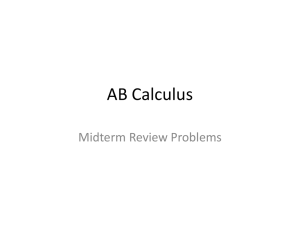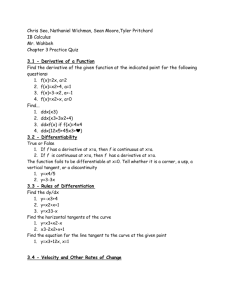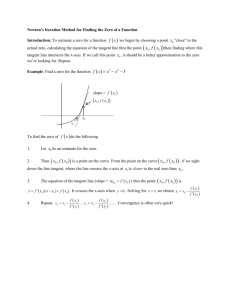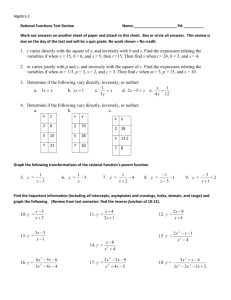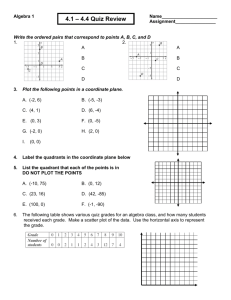FINAL EXAM REVIEW 2015 ANSWERS – Fall Semester Honors
advertisement
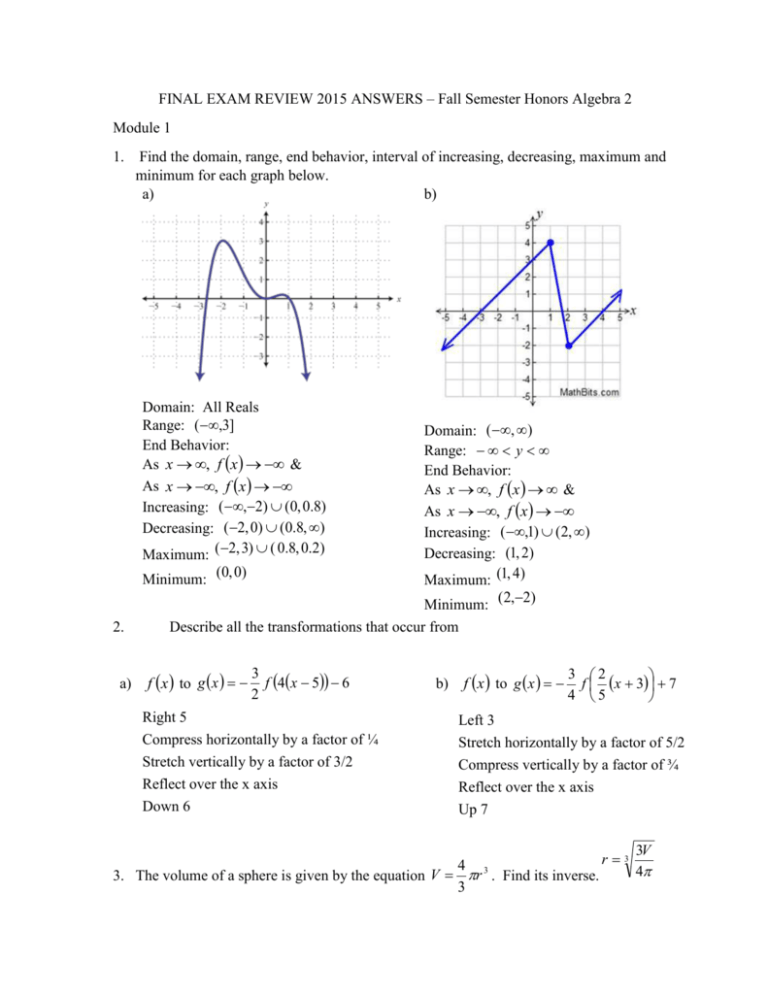
FINAL EXAM REVIEW 2015 ANSWERS – Fall Semester Honors Algebra 2
Module 1
1. Find the domain, range, end behavior, interval of increasing, decreasing, maximum and
minimum for each graph below.
a)
b)
Domain: All Reals
Range: (,3]
End Behavior:
As x , f x &
As x , f x
Increasing: ( ,2) (0, 0.8)
Decreasing: ( 2, 0) (0.8, )
Maximum: ( 2, 3) ( 0.8, 0.2)
Minimum: (0, 0)
2.
a)
Domain: ( , )
Range: y
End Behavior:
As x , f x &
As x , f x
Increasing: ( ,1) (2, )
Decreasing: (1, 2)
Maximum: (1, 4)
Minimum: ( 2,2)
Describe all the transformations that occur from
f x to g x
3
f 4 x 5 6
2
Right 5
Compress horizontally by a factor of ¼
Stretch vertically by a factor of 3/2
Reflect over the x axis
Down 6
b)
f x to g x
3 2
f x 3 7
4 5
Left 3
Stretch horizontally by a factor of 5/2
Compress vertically by a factor of ¾
Reflect over the x axis
Up 7
r
4
3. The volume of a sphere is given by the equation V r 3 . Find its inverse.
3
3
3V
4
4. The monthly cost C (in dollars) a utility company charges for natural gas is
C = 0.03T + 75, where T is the number of Therms of gas used that exceed 45 Therms per month.
Find its inverse.
T
100C
2500
3
5. Find the average rate of change from the interval of time from
a) 30 seconds to 70 seconds
1m
2s
b) 40 seconds to 90 seconds
4m
5s
c) 100 seconds to 120 seconds
0m
s
6. The table shows the weight in hundreds of pounds and the average miles per gallon for
selected 1999 cars
Weight
17.5
20
22.5
22.5
25
27.5
35
45
22.5
????
65.4
49
59.2
38.9
40.7
46.9
27.7
??
41.1
35.2
(100 lbs)
Fuel
economy
(mpg)
a) Define the variables:
X = weight of the car in 100 lbs
Y = fuel economy in mpg
b) Find the equation of the regression line for the data. What is the correlation value? Is the
correlation weak, moderate, or strong?
Y = -1.72x + 87.6
R = -0.77 (moderate)
c) If the equation of the regression line shows a moderate to strong relationship, predict the
missing value. Write a complete sentence to tell what you just found represent. Explain if
your prediction reliable.
X = 45, y = 10.02. A car that weighs 4500 lbs will have a fuel economy of about 10 mpg
Y = 35.2, x = 30.46. A car that weighs about 3046 lbs will have a fuel economy of 35.2 mpg
Prediction may be is reliable (notice the correlation is not strong)
Module 3
Subtract or Add
7. What is the result of subtracting (-3+6i) from (4i +8)?
11 – 2i
8. What is the result of subtracting (9i - 4) from (-2i -7)?
-3 – 11i
Multiply, Add or Subtract and identify the solutions as complex numbers, real or imaginary
numbers.
9. (7-2i)(8+2i)
60 – 2i
10. (-2+3i) + (2-5i)
-2i
11. (6-i) - (3-4i)
3 + 3i
12. (1+4i) (2-3i)
14 + 5i
Use the discriminant (
13.
14.
- 4ac) to tell how many and type of solutions.
D = - 4 , 2 complex imaginary answers
D = 265, 2 real answers
Solve by co
15.
16.
mpleting the square.
x 3 15
x 2i
Applications
17. A pedestrian suspension bridge built above a road is supported by a parabolic arch. The
height in feet of the arch is given by the equation h(x) = x 2 20 x . Can a tractor with a height
of 14 feet pass under the highest point of the arch? Use the discriminant to explain your
reasoning. Yes, since the discriminant is positive.
18. The height in feet of a softball t seconds after it is hit straight up in the air with a velocity of
28 ft/s is given by h(t ) 4.9t 2 28t 2.1 . Will a softball hit straight up with this velocity hit
the roof of a batting cage with a maximum height of 125 feet? Find the correct answer by using
the discriminant. Yes, since the discriminant is positive.
Module 4
Solve each system algebraically.
9 y 6 x 0
19. x 2 y 2
1
45 5
(3,2) & (-3, -2)
20.
x 2 y 2 34
3 x 3 y 6
(-3, -5) & (5,3)
Write the equation in standard form for each parabola.
21. Focus (1, 0), directrix x 3
22. Vertex (4, 6), focus (4, 2)
8( x 1) y 2
( x 4) 2 32( y 6)
Solve the system of linear equations.
x 3 y 4z 10
23. 5 x 10 y 5z 12
4 x 8 y 4z 9
24.
x 3 y 4z 10
5 x 10 y 5z 12
4 x 8 y 4z 9
No solution
25. Find the equation of the parabola passing through the points:
a) (-3, -28), (1, 4) and 4, -16)
b) (-4, 69), (-2, 15), and (3, 20)
y
44 2 80
16
x
x
21
21
7
y 4 x 2 3x 7
Or y 44 x 2 80 x 48
2 y 8 x 2 6 x 14
Or any multiples of the first answer
Or any multiples of the first answer
Module 5
For each of the following graphs of the cubic functions, write the equation that models the function.
26.
y 2( x 1) 3 2
27. y 0.4( x 3) 3
For each of the following graphs, write the lowest degree polynomial in factored form.
28. y ax( x 1) 2 ( x 4) , where a < 0
29. y a ( x 3)( x 1)( x 5) , where a > 0
30. Describe the transformation of 𝑓(𝑥) = 𝑥 3 to
A) 𝑔(𝑥) = 6(𝑥 − 4)3 + 1 right 4, vertically stretched by a factor of 6, up 1
1
B) ℎ(𝑥) = − 2 (𝑥 + 3)3
C)
1
3
𝑔(𝑥) = (4 𝑥) − 8
left 3, reflect over the x axis, vertically compressed by a factor of 1/2
horizontally stretched by a factor of 4, down 8
Module 6.1 & 6.
Add or subtract. Write your answer in Standard Form.
32. (x + 2 − 8x2) + (3x + 26x2 − 2)
18 x 2 4 x
33. (61x8 + 23x2 − 6) + (11x + 7x8 − 46x2 + 3)
68 x 8 23 x 2 11x 3
34. (6x3 + 57x4 − 13x + 8) − (−12x3 + 9x + 28)
57 x 4 18 x 3 22 x 20
35. (9x − 12x3) − (6x3 + 6x − 5)
18 x 3 3 x 5
36. (14x2 − x + 3) − (7x + 1) + (8x − 11)
14 x 2 9
Multiply. Write your answers in Standard Form.
37. (3x − 5)(3x2 + 7x − 1)
38. (x3 + 9x2 + 1)(3x2 + 2x − 8)
39. (3x2 + 8x + 7)(3x2 + 4x – 1)
9 x 3 6 x 2 38 x 5
2 x 4 10 x 3 69 x 2 2 x 8
9 x 4 38 x 3 31x 2 20 x 7
6.3
Use the Binomial Theorem to expand each power of a binomial.
40. (x 7)7
x7 49x6 1029x5 12,005x4 84,035x3 352,947x2 823,543x 823,543
40. (3x 2)6
729x6 2916x5 4860x4 4320x3 2160x2 576x 64
41. Identify the x-intercepts, end behavior and maximum number of turns. Determine if each function
has any global or local maximums or minimums. Identify x-intercepts that cross the x-axis and
intercepts that are tangent to the x-axis.
𝑚(𝑥) = −5(𝑥 + 3)2 (𝑥 − 6)2 , x-int: {-3, 6}
As x , m( x) and As x , m( x)
3 turns max
No global min
1 local min
2 global/local max
Both x intercepts are tangent to the x axis
1
𝑘(𝑥) = 4 𝑥 2 (𝑥 − 9) x-int: {0, 9}
As x , m( x) and As x , m( x)
2 turns max
No global min/max
1 local min & 1 local max
Tangent at x = 0, crossing at x = 9
𝑓(𝑥) = 8(𝑥 + 1)(𝑥 − 2)(𝑥 + 7)2 x-int: {-1, 2, -7}
As x , m( x) and As x , m( x)
3 turns max
1 global/local min
1 local max
No global max
Tangent at x = -7, crossing at x = -1 & x = 2
𝑔(𝑥) = −(𝑥 + 4)(𝑥 + 2)(𝑥 − 1) x-int: {-4, -2, 1}
As x , m( x) and As x , m( x)
2 turns max
No global min or max
1 local max
1 local min
All x intercepts cross the x axis
1
ℎ(𝑥) = − 6 (𝑥 − 5)2 (𝑥 + 3)
x-int: {5, -3}
As x , m( x) and As x , m( x)
2 turns max
No global min or max
1 local max
1 local min
Tangent at x = 5, crossing at x = -3
𝑗(𝑥) = 𝑥(𝑥 + 10)2
x-int: {0, -10}
As x , m( x) and As x , m( x)
2 turns max
No global min or max
1 local max
1 local min
Tangent at x = -10, crossing at x = 0
42. You are given a sheet of cardboard that measures 5 feet long by 2.5 feet wide, with instructions to
create an open-topped box by removing a square flap of side length x from each of the four corners.
Write an equation that models the volume of your completed open-top box in terms of x, then calculate
the value of x that will maximize the volume of the box.
V (x) = (5 – 2x)(2.5 – 2x) x
X = .53 ft will maximize the volume of the box.
43. Bert will cut squares from the corners of a piece of cardboard as shown so he can fold up
the resulting flaps to make a box. Create an equation that models the volume of Bert’s
open-top box in terms of h, then calculate the value of h that will maximize the volume of
the box.
V (h) = (45 – 2)(37 – 2h) h
X= 6.74 in will maximize the volume of the box
44. Use long division to find the quotient for each of the following:
2x 1
6x 2x 3
23x
9x 2 2
x 6x 4
17 x 25
3x 4 2
7 x 5x 2
7x 2
A) (42𝑥 3 − 26𝑥 2 + 27𝑥 − 7) ÷ (6𝑥 2 − 2𝑥 + 3)
B) (9𝑥 3 − 52𝑥 2 + 47𝑥 + 8) ÷ (𝑥 2 − 6𝑥 + 4)
C) (21𝑥 3 − 13𝑥 2 − 9𝑥 − 17) ÷ (7𝑥 2 + 5𝑥 − 2)
2
45. Use synthetic division to find the quotient for each of the following:
A) (2𝑥 3 − 53𝑥 + 27) ÷ (𝑥 − 5)
B) (17𝑥 3 − 63𝑥 2 + 35𝑥 − 5) ÷ (𝑥 + 3)
C) (6𝑥 3 + 5𝑥 2 − 18𝑥 + 58) ÷ (2𝑥 − 1)
12
x5
1136
17 x 2 114 x 377
x3
2 x 2 10 x 3
cannot be done with synthetic division
Factor
46. x 9 x 6 x 3 1
( x 1) 2 ( x 2 x 1) 2 ( x 1)( x 2 x 1)
47. x 6 26 x 3 27
( x 3)( x 2 3x 9)( x 1)( x 2 x 1)
48. 8m2 + 58m – 85
(4m – 5) (2m +17)
49. -192w2 + 432w – 243
-3 (8w – 9)2
50. A new rectangular holding tank is being built. The tank’s sides and bottom should be 1 foot thick.
Its out length should be twice its outer width and height. What should the outer dimensions of the tank
be if it is to have a volume of 36 cubic feet?
8 by 4 by 4 feet.





